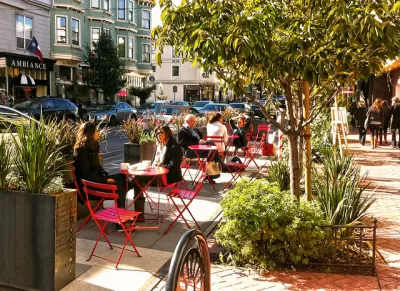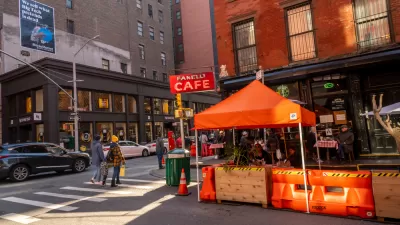The social and economic upheaval of the last two years accelerated a shift in thinking about how we use public space and organize the urban realm.

After decades of glacial progress on shifting public space away from a focus on cars, the disruption brought on by COVID-19 led to a radical rethinking of how we use roads and sidewalks. As Adam Rogers writes,
The virus—and specifically the understanding that as an aerosol it spread more easily in poorly ventilated spaces—changed something fundamental about urban life. The expansion of restaurants to curbside spaces and the closure of city streets to automobiles began in 2020, but in 2021 those alterations felt like a new phase in a decades-old cold war over the look and feel of the modern city.
Although the pandemic also halted progress that cities were making on increasing density and boosting public transit use, Rogers writes, the focus on social distancing and access to the outdoors brought a new urgency to reinventing the right-of-way for more people-oriented uses and encouraging walkable, bikeable neighborhoods. But this hasn't come without its own challenges: as cities scramble to create new regulatory frameworks for pandemic-era projects, the process often becomes onerous and expensive for small businesses and organizations. Meanwhile, disability advocates caution that some parklets impede access for wheelchairs, and public space proponents criticize dining setups for using public right-of-way for private businesses.
Nevertheless, Rogers concludes optimistically, "this new image of the city offers a sense of possibility—of hope, even—in the fight against climate change and inequality."
FULL STORY: The Pandemic Might Have Redesigned Cities Forever

Alabama: Trump Terminates Settlements for Black Communities Harmed By Raw Sewage
Trump deemed the landmark civil rights agreement “illegal DEI and environmental justice policy.”

Planetizen Federal Action Tracker
A weekly monitor of how Trump’s orders and actions are impacting planners and planning in America.

The 120 Year Old Tiny Home Villages That Sheltered San Francisco’s Earthquake Refugees
More than a century ago, San Francisco mobilized to house thousands of residents displaced by the 1906 earthquake. Could their strategy offer a model for the present?

Ken Jennings Launches Transit Web Series
The Jeopardy champ wants you to ride public transit.

BLM To Rescind Public Lands Rule
The change will downgrade conservation, once again putting federal land at risk for mining and other extractive uses.

Indy Neighborhood Group Builds Temporary Multi-Use Path
Community members, aided in part by funding from the city, repurposed a vehicle lane to create a protected bike and pedestrian path for the summer season.
Urban Design for Planners 1: Software Tools
This six-course series explores essential urban design concepts using open source software and equips planners with the tools they need to participate fully in the urban design process.
Planning for Universal Design
Learn the tools for implementing Universal Design in planning regulations.
Clanton & Associates, Inc.
Jessamine County Fiscal Court
Institute for Housing and Urban Development Studies (IHS)
City of Grandview
Harvard GSD Executive Education
Toledo-Lucas County Plan Commissions
Salt Lake City
NYU Wagner Graduate School of Public Service




























